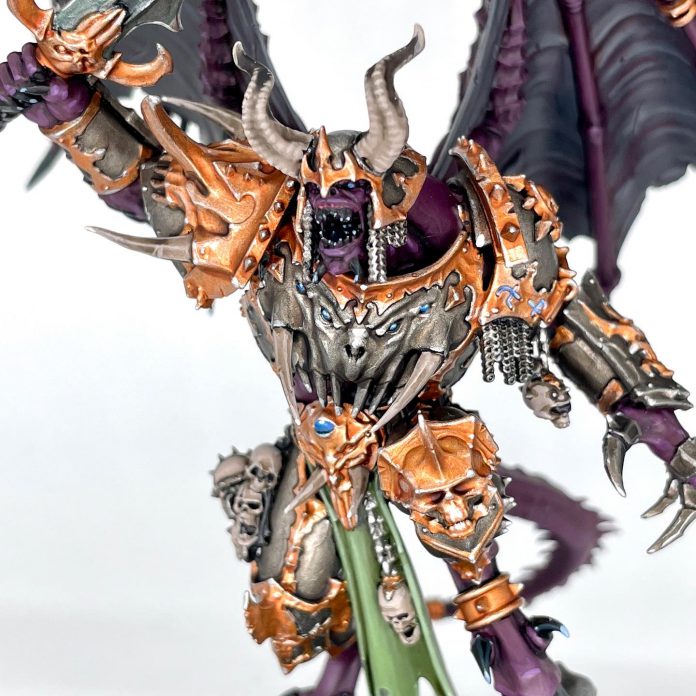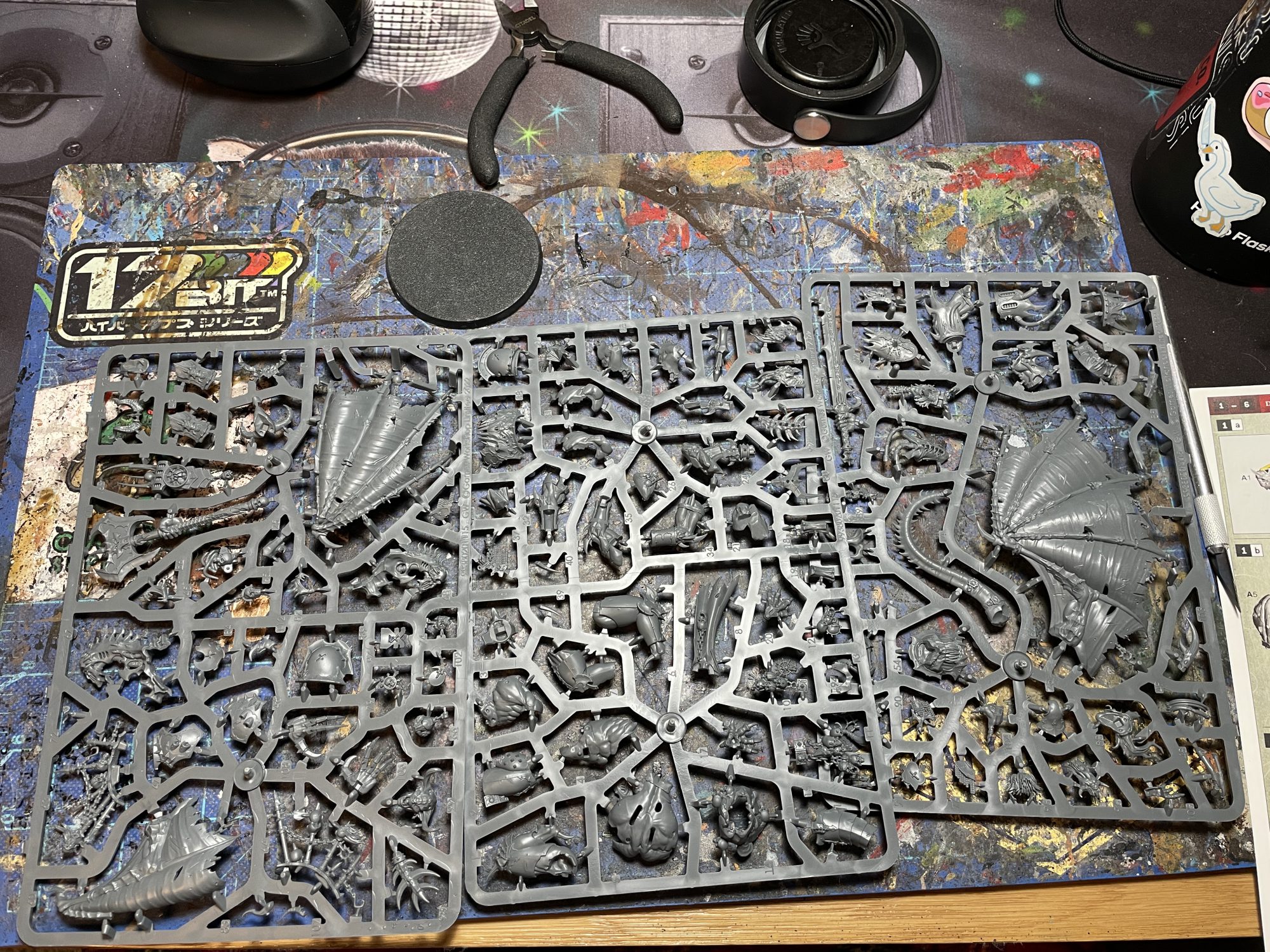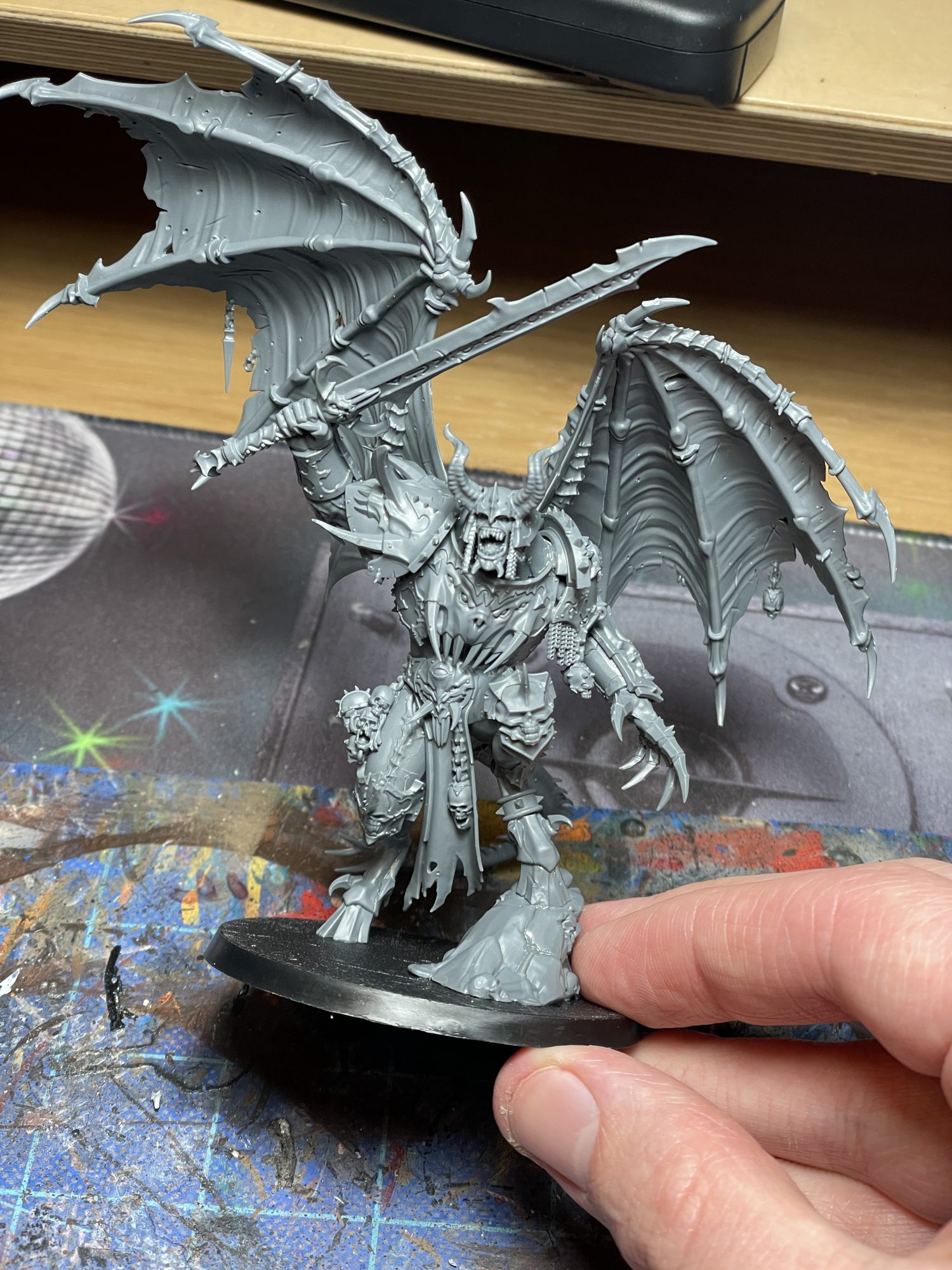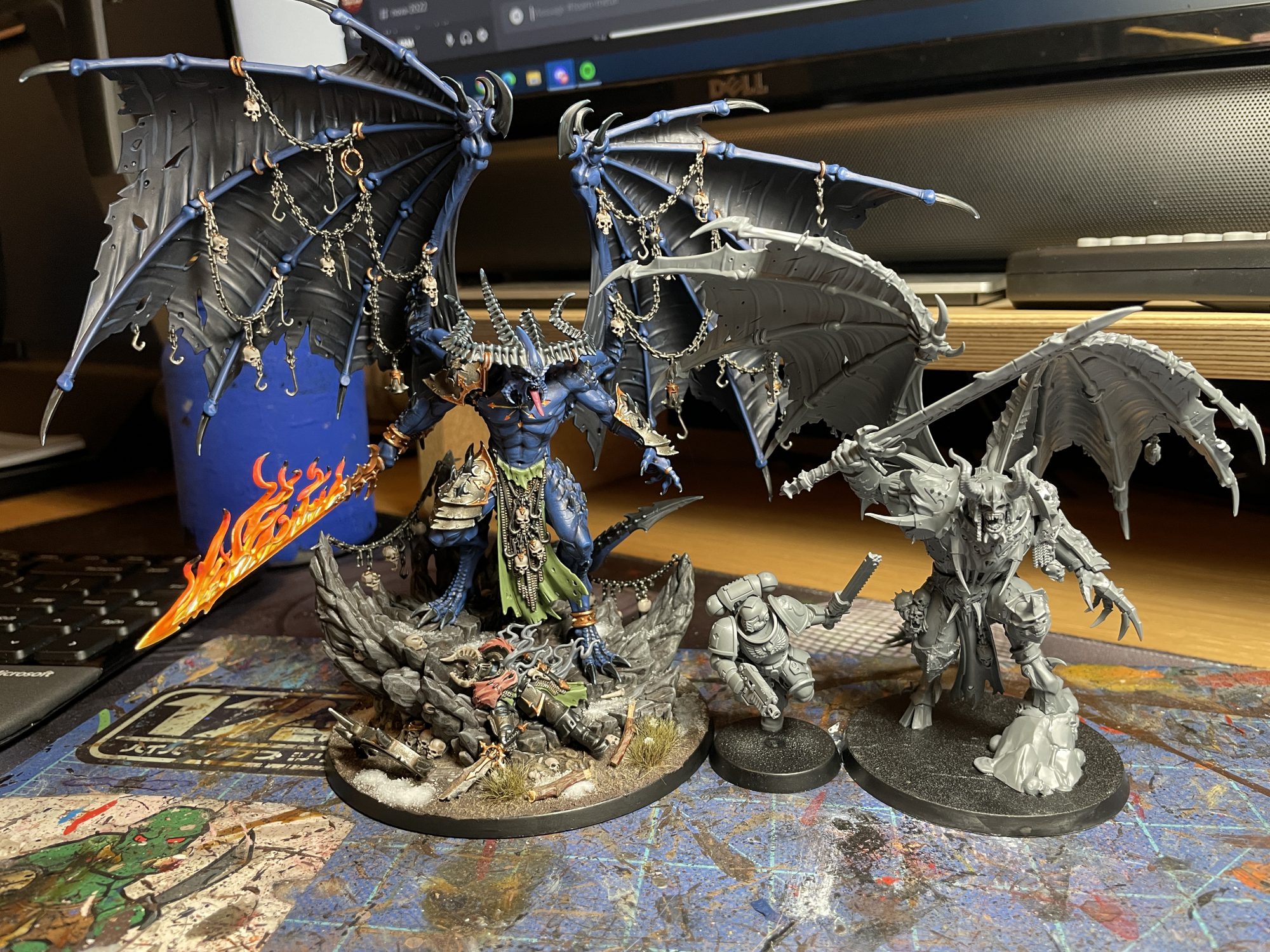We’d like to thank Games Workshop for providing us with a preview copy of the Slaves to Darkness box for review purposes.
As one of the resident Slaves to Darkness players amongst the Goons whomst Hammer, it should come as no surprise that I was hooting and/or hollering at the prospect of getting my hands on this new army box. I will be breaking down each kit therein over the course of a few review articles, and I thought it best to start with what is likely the most hyped model in the whole set: the new Daemon Prince.
Despite playing Chaos Space Marines since 2009 and Slaves to Darkness since 2019, I’ve never owned a Daemon Prince. In this reviewer’s opinion, there hasn’t been a good generic Daemon Prince model aside from the Juan Diaz Chaos Space Marines Daemon Prince from 3rd edition (Rob: The Death Guard metal Daemon prince was also decent). Well, I don’t mean to bury the lede, but I think the sculptors at GW finally cracked the code and made a Daemon Prince that doesn’t just look better than any previous iteration, but is an incredible model in its own right.
Across these three sprues there are over 120 pieces, and you’re going to be using most of them no matter what version of this big lad you build. The instructions in the Slaves to Darkness box don’t detail how to build the Chaos Space Marines variant, as is to be expected. What also surprised me was how small the model seemed – the preview pictures had me thinking he would be roughly Greater Daemon or Be’Lakor-sized, but he fits on a 60mm base with plenty of room to spare.
Construction
It took me just under two hours of pure hobby concentration to build this model. I didn’t have much in the way of analysis paralysis – I knew I wanted him to be Undivided, and I liked the helmeted option better than the bare headed option – but this model is just so damn intricate. I don’t just mean the details (although they are mighty fine and beautiful besides) but in just how fiddly and tight the construction can be. His torso is a smattering of seemingly unrelated fleshy shapes that all fit around a hollow void and if you don’t wait the proper amount of time for glue to dry, the whole body can collapse in on itself as nearly happened with mine. It’s kind of like building an eggshell, fragile and hollow. Each limb is 2-3 parts before the hands and feet (often another 2-3 parts) and even the most seemingly simple part of the model can take a while just to clip, clean, and glue together. His head especially was a challenge, taking something like 6-7 often extremely small pieces just to assemble. Each of his heads has multiple pieces as well, and there’s something like 3 different tongues in the kit. The benefit of all this is a model that truly feels 3-dimensional, with no weird extrusions or mushy details anywhere. Moldlines were almost virtually nonexistent on my model, only notably appearing on the fragile ends of his wings and on one of his muscled torso pieces.
There are so, so many pieces to this model, and the sprues are packed so tightly it can be tricky to get a pair of clippers in there. Said sprues are positively packed, and whatever devil’s bargain was made to fit all these bits on 3 small sprues had some drawbacks as well. In a move that is fairly rare in today’s Citadel miniatures, the bits are scattered across the sprues in a nonlinear fashion. You may need two adjacently numbered pieces for a hand or foot or something, only to have to hunt them down and find which sprue has which piece in the sequence – so bit 17 might be on sprue A, but 18 might be on sprue C. Searching for the specific bit I needed definitely contributed to the construction time on this miniature, as pieces are typically laid out next to each other on kits not quite so packed as this one.
The pieces for different gods are all good on their own – fine sculpts, nicely detailed, and fitting with their respective members of the pantheon – but I find it difficult for a model like this to really sing as a representative for each god. For Undivided or Khorne, this model absolutely works. Big, beefy, and covered in skulls and platemail absolutely scans for those two options. For Tzeentch I can almost see it, but if you compare this model to the Hedonites or Maggotkin ranges, it doesn’t quite fit. Even with the headswaps, it still looks a fairly god-agnostic model trying to ride with those other armies. I think this is less a problem of this model’s design and more a result of how the aesthetics for Chaos have evolved and diversified over the years, but I still wanted to share my thoughts on the matter.
Size Comparison
As previously stated, he’s not all too big. His proportions are far, far better than the plastic iteration, but even with his hero rock he isn’t standing all too tall in the grand scheme of things. Still, he’s certainly big enough to be a centerpiece model in your army, but is dwarfed by the heavier hitters in the Age of Sigmar range. I’ll be honest, I’m relieved he isn’t going to require a whole KR case on his own or whatever.
Options and Magnetization Potential
The one option you really don’t have with this model is simplicity. All of the skulls, chainmail, and so on you see draping off my model in these pictures are integral to the model, covering up gaps or weird divots where they are meant to go. It means that you can’t leave them off unless you’re willing to do some converting, and multiple Daemon Princes in an army are going to look a bit samey despite all the other options in the kit. Still, you can build him with hooves or clawed feet, and there are numerous other options which we’ll get into now.
All I can really say about the Chaos Space Marine bits at this point is that they look cool and I don’t really know how they’d go on. It would be easy enough to make a setting-agnostic Daemon Prince, as there is only one option of a Stormcast or Space Marine helmet to hang off a trophy rack, and there’s one skull on his belt that looks sort of like it has the Inquisition “I” stamped into it. You might be able to magnetize the chestplate to swap between the power armor and platemail options, but it would likely prove tricky as it is wedged in place by his pauldrons. I accidentally left the chestplate off until the end, and wedging it in there was no simple task.
Swapping heads shouldn’t be too difficult; they attach via a diamond-shaped join on the neck of the body that could easily be shaved down and replaced with a shallow magnet, with another in the head’s neck void to match. You could also swap out the tip of his tail for whatever chosen god’s tail piece you want, but I don’t think most people would notice. There are also icons for his left pauldron of a Chaos star or an icon for each of the gods; it’s too fiddly to easily magnetize and I’d probably just leave the generic Chaos star on.
Weapons are going to be the easiest thing to swap around on this guy. His right hand can be built open, or you can put a sword or axe there instead. His hand fits with a simple flat join with one groove that slots into his vambrace to keep it straight. A little drilling would make a handswap trivial, should a sword, axe, or claws be more appealing in one game system or another.
Lastly, he has the option of wings or a trophy rack. In the 17 years I’ve been playing Warhammer, wings have always been the best option for a Daemon Prince, but if you wanted the trophy rack instead it wouldn’t be too hard to swap. There’s a series of ports on his back where these pieces can slot in, and while I don’t think they’re quite tight or deep enough to hold wings on their own, they give you a few easy spots to either put a pin or a magnet so you can swap at your leisure.
Painting

One thing I realized whilst painting the Taint of Chaos on this model was that he’s got some serious cake. Like we’ve all seen bare-chested Warhammer models before, they’re all cut as hell, but this dude does squats, and I’m not talking about those little dwarf guys. I’m trying to say there’s a booty on this model and he’s got assless platemail to show it off.
Even with the mass of the wings on this model, his pose was still open enough that getting to most of the nooks and crannies was an easy process, and the efforts of construction paid off as no details were vague or otherwise unclear. Getting behind his pauldrons is tricky and getting to some details between his wings and arm or tail could be fiddly, but nothing else proved to be all too challenging.
Also a quick note, since it’s paint-related. There was some issue with the combined studio paintscheme and photography of the Daemon Prince model where the crest of the Undivided helmet is blown out, making it look like it’s the same color as their skin, and therefore an extension of their face. With a higher color contrast between the two materials, it’s a much more appealing head option.
Final Thoughts, Parting Shots, and What Have You

As I was building and painting this model, I had a lot of flashbacks to working on Be’Lakor. In a lot of ways, it feels like a model of Be’Lakor’s stature scaled down about 30% with everything that may entail: fiddlier pieces, tinier details, but a less intimidating model overall. Even many of the details – the weird hanging triangle shaped piece of metal, the chains, and the piercings in his wings – all evoke Be’Lakor before him.
While I did find some parts of this model to be kind of a pain, I do get the feeling that whoever sculpted it really, really fucking cared. The sculptors at Games Workshop obviously care about what they do, but something about this model exudes maximum effort on the part of the designers.
Have any questions or feedback? Drop us a note in the comments below or email us at contact@goonhammer.com.





